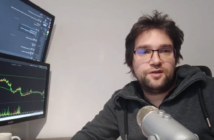I very often hear a fallacious belief that trading only consists in searching for companies to take a long position. Long position i.e. purchase of shares and expectation for a rise or quick move up. But what I like most is trading a downtrend.
On the largest stock exchanges in the world, which are US Stock Markets, traders have possibility to earn also when stocks prices decreases. It is trading on declines – so-called Short Selling. It is possible on companies, on which the broker has available shorts (as usual I note for the appropriate selection of the broker).
What is play on declines, i.e. short selling?
Short selling, that is trading on declines consists in opening a short position in expectation of decline in share price. For example, the trader opens a position at 10.50$, expecting that the company rate will drop. If the rate drops to 10.00$, and trader holds 1000 shares then will earn 500$ (minus commissions). If the rate in the company will grow, e.g. to a level of 10.70$ and trader will decide to close the position – will lose 200$.
PLEASE NOTE! For the sake of clarity, I will turn my attention to one of issue – in play on longa you know how much you lose. If you buy shares at a price of 5$, you know that maximally will drop to 1 cent (or its fraction on Pink Sheets or OTC-BB). Playing on declines – sky is a limit in relation to your risk. Opening the position on declines from price of 5$, you can lose much more because the rate can grow up to 10 – 20 or 50$. Without risk management it is a fast way to disaster.
Therefore remember: if you plan to trade on declines, draw up your strategies and proceedings when the rate will change in an opposite direction. Risk management must constitute a key.
I like shorting stocks
Vast majority of opened position by me constitute shorts. The same is today, it was in 2009-2011 when we noted the greatest increases on S&P 500, and the same was in 2007-2008 when the crisis began and with it severe slump for many.
Maybe it results from the fact that I mostly developed my daytrading during the slump and hence nearly 70% of my transactions constitute short positions? Alone I don’t know. From my point of view, it is simply better to trade on declines for me; they are more “understandable” under setups played by me (on graph and window of Level II – use tape reading).
However, I would like to draw your attention to a fact… Trading every day on American stock exchanges is a chance for perfect longs as well as shorts. Therefore, it is worthwhile to learn or develop strategies that are better and worse on the stock-market. Simplifying the matter, actually graph of the company’s downward, it is simply reversed graph of the company‘s upward 🙂 I already repeatedly met with traders, among others during the last conference which I organized “Your start in the world of daytrading”, who mentioned that they had a problem with switching to trading on declines (particularly in 2008-2009 years). They were so taught by slump: opening only long positions.
What is most important when trading a downtrend
In trading I like the most simplicity. Those who follow my entries for years noticed that on graphs I had only candlesticks and volume. Only that, and yet so much! These two components are a key for me to effective trading. I draw from it all needed information.
Therefore it won’t be anything new, if again I will mark what for me is most importantly in case of trading on declines. And why, I will explain below on the example of specific graphs.
Volume – appears on declines. A volume is confirmation what’s happening on the company. If there is no volume, I give up trading because statistically is more probable that the strategy played by me will be ineffective.
Lengths of candlesticks – on correction they are dynamic. Of course, somebody can show examples of similar behaviors at heights. I won’t quarrel with it – because in both sides it is possible to search for similar changes. However, I want to pay attention to a greater panic amongst traders, particularly when downturns and tested are important support. Then very often beginner traders even more boost declining change. Why? Firstly, sometimes happens that they have longs and a principle appears “I don’t believe that it will farther fall”, when it farther falls they often turn the light and leave the companies already at short prices. Next group are people who too early catch the falling knife. After a moment of thought “It won’t increase” they leave the companies again, helping with declines. Why all this? Since, it is just necessary to observe areas of supports and to wait on good their test, to use a change. Not to struggle with the trend.
Difference in downtrend
Slow growth –> dynamic correction
Below I clearly present how quickly the growth changes generated by 15-20 sessions was reversed with dividends. It was enough that news appeared to change from 12 to 13$, negated in one sessions, and next came to drop below 11$.
As you can see the trend reversal, additional news and we have what we didn’t experience previously on the company:
-
volume significantly deviated from the norm
Note that in sessions preceding slump, the daily volume was in a range of 100-600k shares. In a moment when the first strong decreasing session was generated the volume jumped into a few million shares of the turnover.
-
lengths of individual candlesticks
Candlesticks usually generated 1-2-3 cent of changes. Suddenly lengths of candlesticks increased to 10-40 cents.
Admit that statistics grew incomparably – nearly 10 times compared to normal. Within about 20 sessions, the company has grown less than a dollar. In one there was a dynamic drop from 12.60$ to a level slightly below 11$.
Reversal after strong heights –> dynamic correction
Another very similar example on the PLUG Company; the company during 9 sessions had a strong growth changes: from 3.5$ to nearly 12$. Impressive! However, even more impressive was the reversal of trend.
As can be seen the reversal of trend brought changes in components, which for me are crucial:
-
volume significantly deviated from the norm
The volume at prior height was already considerable, but while reverse it increased even more.
-
lengths of individual candlesticks
Candlesticks usually generated 20-30 cent of changes. 2 sessions preceding the decline, were characterized by 2-2.5$ candlesticks. Reversal session brought nearly 5$ of generated change in 1 session.
Candlesticks during decline –> faith in reversal
A slightly different example; this time expected breakdown below 8-7.90$ on the WIN Company reaches breaking through with decline. Experienced trader, who had long, leaves the position. Other who waited to open short – will carry out order of opening position. Inexperienced traders may however have a problem. Problem resulting from a simple fact – it’s a lack of ability to adapt to changing market and rapid response to some upcoming chances.
Trader could have a long position counting on other changes of 8$. However, when he saw that a larger volume appeared and breaking through below 8$ to 7.90$ – was able to close the position and reverse opening short. Thanks to that quickly took a small loss, which fulfilled his assumptions in relation to the risk management. At the same time he opened a short position, increasing his chances for profit. “Crack” of so long built up support usually leads to stronger and dynamic drop.
Common mistake of inexperienced trader
He stayed in a long position. Why? Because he didn’t believe that there would be breaking through, and when it already occur, he stated that “certainly will be back”. The first sign of complacency from the rightness of his assumptions he could have on a level of 7.70-80$ where was a small upward correction (often in such a moment inexperienced trader is averages its position). However, after a while the rate continued to fall up to 7.50-60$, where was a further consolidation. It should show him already a certain type of scheme: consolidation 8-7.90$ –> drop 7.90$ to 7.70$ –> consolidation 7.70-80$ –> drop 7.50-60$. If a prior change will repeat, there will be another downward, but the loss of inexperienced trader will grow.
What for?
The position thought over would be closed a long time. Trader who has own strategies that can be used in trading on declines, would have a short position enjoying profit. Inexperienced trader is stuck in a loss position struggling with the market.
Again during downward turn, I pay attention to:
-
volume significantly deviated from the norm
Volume before breakdown was on a level of 300-700 thousand shares per day. During breaking through the volume jumped to 500 k – 1.5 million shares per day.
-
lengths of individual candlesticks
Candlesticks usually generated 3-5 cent of changes. During breaking through the changeability grew up to 10-20 cent of candlesticks.
Next confirmation of the key importance of two factors mentioned above.
Trading example in video:
My purpose is not to convince you to start playing only on declines. But to draw attention to the fact that it is worth to add to your strategy those that involve playing on shorts. Having both an effective strategy on upward and downward changes, increases your potential profits! Especially it is worth to think about it now (development of the strategy is time-consuming). I think that strong declines (not necessarily such as in 2007-2009) is a matter closer to months rather than years. I hope that I’m not wrong 🙂
I hope that above information will turn out to be useful. Or maybe you would like to share your graphs. Find graphs corresponding to the above objectives and share them with me. If you just start – use http://www.freestockcharts.com where you can for free analyze graphs. Feel free to add comments below.








